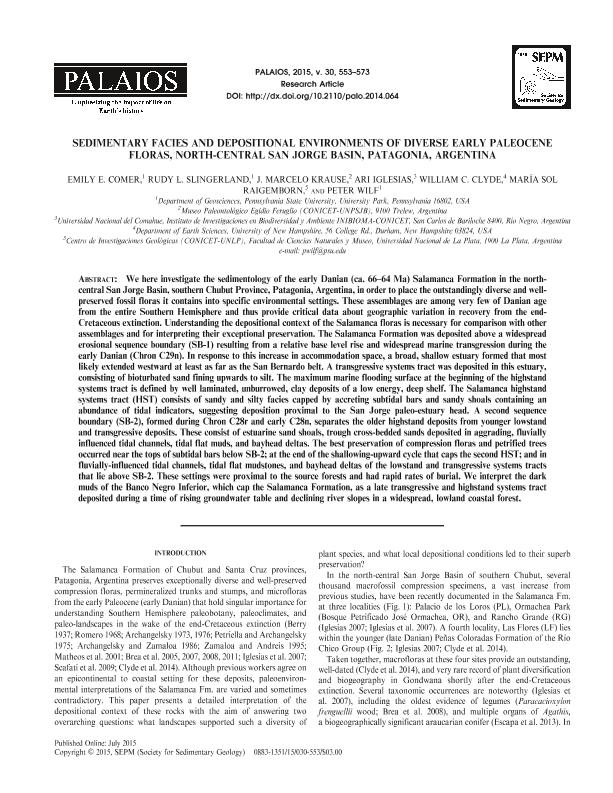Artículo
Sedimentary facies and depositional environments of diverse early paleocene floras, north-central San Jorge basin, Patagonia, Argentina
Comer, Emily E.; Slingerland, Rudy L.; Krause, Javier Marcelo ; Iglesias, Ari
; Iglesias, Ari ; Clyde, William; Raigemborn, María Sol
; Clyde, William; Raigemborn, María Sol ; Wilf, Peter
; Wilf, Peter
 ; Iglesias, Ari
; Iglesias, Ari ; Clyde, William; Raigemborn, María Sol
; Clyde, William; Raigemborn, María Sol ; Wilf, Peter
; Wilf, Peter
Fecha de publicación:
07/2015
Editorial:
Society for Sedimentary Geology
Revista:
Palaios
ISSN:
0883-1351
Idioma:
Inglés
Tipo de recurso:
Artículo publicado
Clasificación temática:
Resumen
We here investigate the sedimentology of the early Danian (ca. 66-64 Ma) Salamanca Fm. in the north-central San Jorge Basin, southern Chubut Province, Patagonia, Argentina, in order to place the outstandingly diverse and well-preserved fossil floras it contains into specific environmental settings. These assemblages are among very few of Danian age from the entire Southern Hemisphere and thus provide critical data about geographic variation in recovery from the end-Cretaceous extinction. Understanding the depositional context of the Salamanca floras is necessary for comparison with other assemblages and for interpreting their exceptional preservation. The Salamanca Fm. was deposited above a widespread erosional sequence boundary (SB-1) resulting from a relative base level rise and widespread marine transgression during the early Danian (Chron C29n). In response to this increase in accommodation space, a broad, shallow estuary formed that most likely extended westward at least as far as the San Bernardo belt. A transgressive systems tract was deposited in this estuary, consisting of bioturbated sand fining upwards to silt. The maximum marine flooding surface at the beginning of the highstand systems tract is defined by well laminated,unburrowed, clay deposits of a low energy, deep shelf. The Salamanca highstand systems tract (HST) consists of sandy and silty facies capped by accreting subtidal bars and sandy shoals containing an abundance of tidal indicators, suggesting deposition proximal to the San Jorge paleo-estuary head. A second sequence boundary (SB-2), formed during Chron C28r and early C28n, separates the older highstand deposits from younger lowstand and transgressive deposits. These consist of estuarine sand shoals, trough cross-bedded sands deposited in aggrading, fluvially-influenced tidal channels, tidal flat muds, and bayhead deltas. The best preservation of compression floras and petrified trees occurred near the tops of subtidal bars below SB-2; at the end of the shallowing-upward cycle that caps the second HST; and in fluvially-influenced tidal channels, tidal flat mudstones, and bayhead deltas of the lowstand and transgressive systems 48 tracts that lie above SB-2. These settings were proximal to the source forests and had rapid rates of burial. We interpret the dark muds of the Banco Negro Inferior, which cap the Salamanca Formation, as a late transgressive and highstand systems tract deposited during a time of rising groundwater table and declining river slopes in a widespread, lowland coastal forest.
Archivos asociados
Licencia
Identificadores
Colecciones
Articulos(CIG)
Articulos de CENTRO DE INVEST.GEOLOGICAS (I)
Articulos de CENTRO DE INVEST.GEOLOGICAS (I)
Articulos(INIBIOMA)
Articulos de INST. DE INVEST.EN BIODIVERSIDAD Y MEDIOAMBIENTE
Articulos de INST. DE INVEST.EN BIODIVERSIDAD Y MEDIOAMBIENTE
Articulos(SEDE CENTRAL)
Articulos de SEDE CENTRAL
Articulos de SEDE CENTRAL
Citación
Comer, Emily E.; Slingerland, Rudy L.; Krause, Javier Marcelo; Iglesias, Ari; Clyde, William; et al.; Sedimentary facies and depositional environments of diverse early paleocene floras, north-central San Jorge basin, Patagonia, Argentina; Society for Sedimentary Geology; Palaios; 30; 7; 7-2015; 553-573
Compartir
Altmétricas



